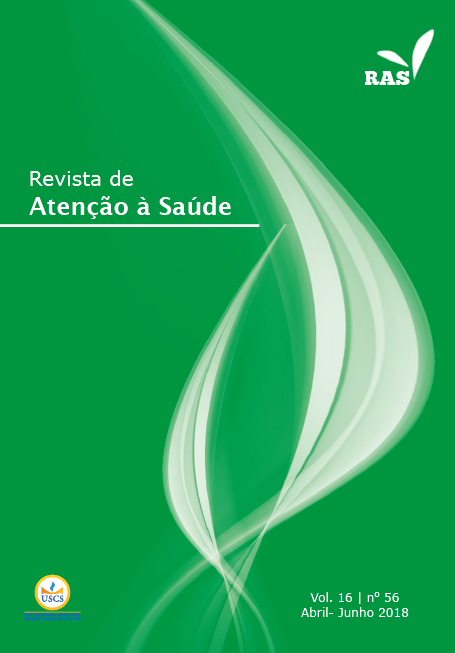EQUITY IN THE DISTRIBUTION OF SANITARISTS FORMED TO WORK ON SUS
DOI:
https://doi.org/10.13037/ras.vol16n56.5169Keywords:
Unified Health System, health personnel, public health, human resourcesAbstract
Introduction: The qualification of sanitarians to perform on the National Health System (SUS) representan important action for the formulation and development of public policies. However, such professionalsneed to be present in the several municipalities, including those where human development conditions areless favourable. Objective: To analyse the distribution equity of qualified sanitarians in Mato Grosso doSul, from 2008 to 2013, in the public health service, considering the Human Development Index (HDI)of the municipality where they resided and worked. Methods: this is a descriptive study with quantitativeapproach, using secondary data of the register of graduates of specialisation courses on public health,developed by the Health Department of the State of Mato Grosso do Sul. From that database, the variablesof interest were extracted: gender, occupation, residing municipality, distribution of professionals byhealth region and by HDI stratum. Results: In the period, three specialisation courses on public healthwere held, totalising 61 sanitarians, coming from 20 out of the 79 state’s municipalities. There was a prevalenceof female gender (83.6%), nursing occupation (29.5%), and professionals who reside and workin the health region of Campo Grande (70.5%), the most populous city, with the best HDI in the state,prevailed. Conclusion: The results suggest that there are difficulties to guarantee the distribution equityof sanitarians in the SUS in Mato Grosso do Sul, since the qualification and the location for professionalexercise are not articulated to supply the health demand of municipalities with smaller HDI.Downloads
References
Moreira LM, Velho L. Trajetória de egressos da pós-graduação do Instituto de Pesquisas Espaciais: uma ferramenta para avaliação. Avaliação, Campinas; Sorocaba. São Paulo, 2012;17(1):257-88.
Organización Paramericana de La Salud (OPAS). Estrategia para el desarrolo de competências del personal de salud en los sistemas de salud basados en la atención primaria de salud. 50º Consejo Directivo: OPAS, 2010.
Brasil. Lei n° 8.080, de 19 de setembro de 1990. Dispõe sobre as condições para a promoção, proteção e recuperação da saúde, a organização e o funcionamento dos serviços correspondentes e dá outras providências. Diário Oficial da União, Brasília-DF, 20 set. 1990 [acesso em 30 jul 2015]; p. 018055. Disponível em: http://www.planalto.gov.br/ccivil_03/Leis/L8080.htm.
Batista KBF, Gonçalves OSJ. Formação dos profissionais de saúde para o SUS: significado e cuidado. Saude soc. São Paulo, 2011; 20(4): 884-899.
Souza JMP. Recursos humanos em saúde pública. Rev Saúde Pública. São Paulo, 1976; 10(3):253-256.
Brasil. Lei nº 9.394, de 20 de dezembro de 1996. Estabelece as diretrizes e bases da educação nacional. Brasília, 1996.
Brasil. Ministério da Saúde. Secretaria de Gestão do Trabalho e da Educação na Saúde. Política Nacional de Educação Permanente em Saúde. Brasília: Ministério da Saúde, 2009.
Mato Grosso do Sul. Secretaria de Estado de Saúde. Escola de Saúde Pública de Mato Grosso do Sul. Dados sobre o Projeto Pedagógico do Curso de Especialização em Saúde Pública. Mato Grosso do Sul: SES-MS, 2008.
Atlas de Desenvolvimento Humano no Brasil. Índice de desenvolvimento humano municipal brasileiro. Brasília: PNUD, Ipea, 2013.
Mato Grosso do Sul. Secretaria de Estado de Saúde. Dados sobre o Plano Diretor de Regionalização (PDR) de Mato Grosso do Sul. Mato Grosso do Sul: SES-MS, 2013.
BRASIL. Conselho Nacional de Saúde – CNS. Resolução nº 287, de 08 de outubro de 1998. Estabelece as categorias profissionais de saúde de nível superior. Brasília, 1998.
Matos IB, Toassi R F C, Oliveira MC. Profissões e ocupações de saúde e o processo de feminização: tendências e implicações. Athenea Digital. 2013; 13(2):239-244.
Chaves ITS. O desafio da formação em transdisciplinaridade e multiprofissionalidade para atender ao princípio da integralidade. Revista Digital de Educação Permanente em Saúde. 2004; 1(1):14-15.
Bezerra APS, Andrade BBL, Batista BS, Reis CR, Arenhart CGM, Parente CG, et al. Quem são os novos sanitaristas e qual seu papel? Rev Tempus Actas Saúde Col. Brasília, 2013; 7(3); 57-62.
Avellar SOC. Migração interna de mestres e doutores no Brasil: algumas considerações. Revista Brasileira de Pós-Graduação. Brasília, 2014; 11(24): 429-457.
Machado M H(coord.). Os médicos no Brasil: um retrato da realidade. Rio de Janeiro: FIOCRUZ, 1997.
Machado MH. Mercado de Trabalho em Saúde e Dinâmica da Oferta e Demanda. In: Conferência Internacional sobre Pesquisas em Recursos Humanos. Anais... Rio de Janeiro: Centro Colaborador da OPAS/OMS, 2010.
Chen R, Zhao Y, Du J, Wu T, Huang Y, Guo A. Health Workforce Equity in Urban Community Health Service of China. PLOS One. 2014; 9(12):1-15.
Rizzoto MLF, Gil CRR, Carvalho M, Fonseca ALN, Santos MF. Força de trabalho e gestão do trabalho em saúde: revelações da Avaliação Externa do Programa Nacional de Melhoria do Acesso e da Qualidade da Atenção Básica no Paraná. Saúde debate. Rio de Janeiro, 2014; 38( no.spe): 237-251
Travassos C, Martins M. Uma revisão sobre os conceitos de acesso e utilização de serviços de saúde. Cad Saúde Pública. 2004; 20(Supl. 2):190-198.
Scarpin JE, Slomski V. Estudo dos fatores condicionantes do índice de desenvolvimento humano nos municípios do estado do Paraná: instrumento de controladoria para a tomada de decisão na gestão governamental. Rev. Adm. Pública. Rio de Janeiro, 2007; 41(5):909-933.
Santos AM, Giovanella L. Governança regional: estratégias e disputas para a gestão em saúde. Rev Saúde Pública. São Paulo, 2014; 48(4): 622-631.
Tess BH, Aith FMA. Intersectorial health-related policies: the use of a legal and theoretical framework to propose a typology to a case study in a Brazilian municipality. Ciênc. saúde colet . Rio de Janeiro, 2014;19(11): 4449-4456.
Downloads
Published
Issue
Section
License
Policy Proposal for Journals offering Free Delayed Access
Authors who publish in this magazine agree to the following terms:
- Authors maintain the copyright and grant the journal the right to the first publication, with the work simultaneously licensed under a Creative Commons Attribution License after publication, allowing the sharing of the work with recognition of the authorship of the work and initial publication in this journal.
- Authors are authorized to assume additional contracts separately, for non-exclusive distribution of the version of the work published in this magazine (eg, publishing in institutional repository or as a book chapter), with the acknowledgment of the authorship and initial publication in this journal.
- Authors are allowed and encouraged to publish and distribute their work online (eg in institutional repositories or on their personal page) at any point before or during the editorial process, as this can generate productive changes, as well as increase impact and citation of the published work (See The Effect of Open Access).









